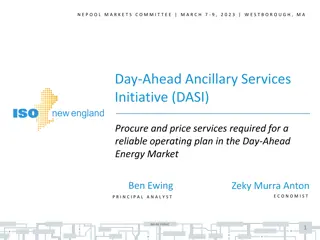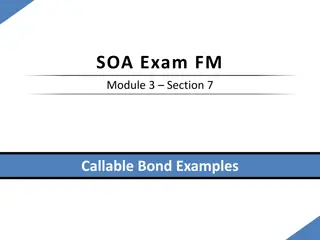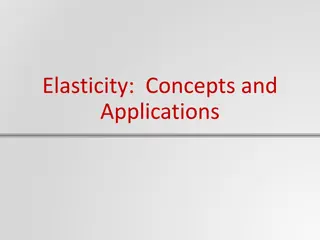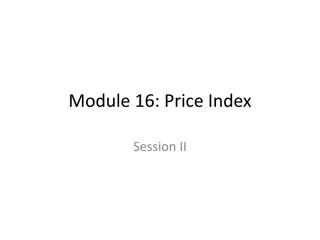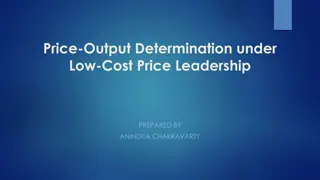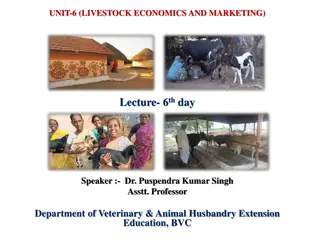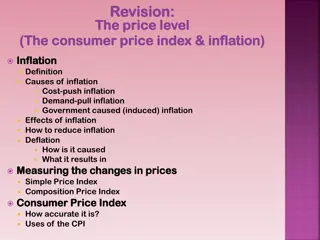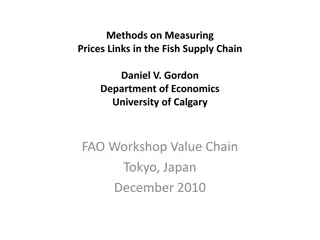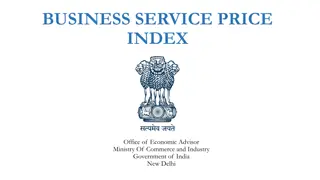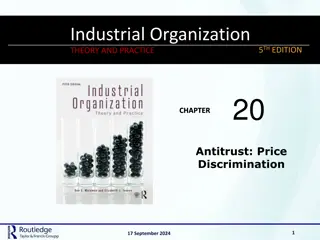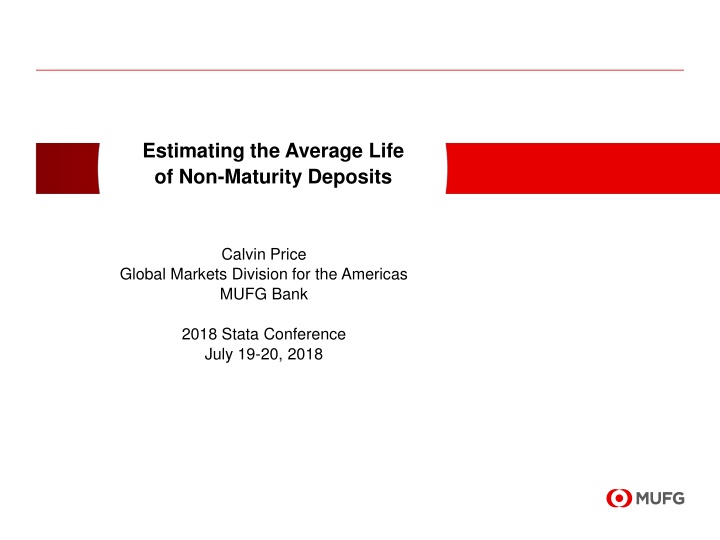
The Average Life of Non-Maturity Deposits in Banking
Explore the concept of non-maturity deposits in banking, their importance, decay rates, and calculation of average life. Discover why estimating the lifetime of deposits is crucial for banks and how it impacts market value. Gain insights into the decay rate formula and how it relates to exponential growth or decay scenarios.
Download Presentation

Please find below an Image/Link to download the presentation.
The content on the website is provided AS IS for your information and personal use only. It may not be sold, licensed, or shared on other websites without obtaining consent from the author. If you encounter any issues during the download, it is possible that the publisher has removed the file from their server.
You are allowed to download the files provided on this website for personal or commercial use, subject to the condition that they are used lawfully. All files are the property of their respective owners.
The content on the website is provided AS IS for your information and personal use only. It may not be sold, licensed, or shared on other websites without obtaining consent from the author.
E N D
Presentation Transcript
Estimating the Average Life of Non-Maturity Deposits Calvin Price Global Markets Division for the Americas MUFG Bank 2018 Stata Conference July 19-20, 2018
What are non-maturity deposits? Banks use many deposit products, two basic types: Term deposits There is a contractual ending point, the money goes back to the customer at a known date Non-Maturity deposits (NMD) No contractual ending point, money can possibly stay with bank forever For a fixed set of customers we know NMD balances grow smaller over time Question: How long can we expect NMD to last? 2
Why is lifetime of deposits important? Market value of the deposit (present value) Longer lifetime, lower market value This is the reverse of more familiar future value calculation, longer lifetime, greater future value Key calculation for banks: MV(Loans) MV(Deposits) Computing market value of NMD requires some assumption about lifetime Banks have incentive to desire smaller MV(Deposits), longer lifetime 3
What is a decay rate? A percentage of something dies per unit of time No fixed amount is dying, just a fixed proportion Any group where rate of change is proportional to size is necessarily exponential growth/decay Common examples: atomic particles, population, money (continuous compounding) Functional form: ? = ????? r positive = exponential growth r negative = exponential decay 4
What is a decay rate? A percentage of something dies per unit of time No fixed amount is dying, just a fixed proportion Any group where rate of change is proportional to size is necessarily exponential growth/decay Common examples: atomic particles, population, money (continuous compounding) Functional form: ? = ????? Starting value = 100 Decay rate = .07 Starting value = 100 Decay rate = .12 100 100 r positive = exponential growth r negative = exponential decay 75 75 50 50 25 25 Avg Life = 14.3 yrs Avg Life = 8.3 yrs 0 0 0 Given a decay rate and starting amount, we can compute the average life 5 10 15 20 0 Given a decay rate and starting amount, we can compute the average life 5 10 15 20 5
What is an average life? Average time a member will exist without dying Assuming the group exhibits exponential decay Same as expected value of any random variable We use probability density governing a particle remaining up to time t (cdf, function of decay rate r) Using the pdf and taking expectation, the mean lifetime is ? =1 ? 6
What is an average life? Average time a member will exist without dying Assuming the group exhibits exponential decay Same as expected value of any random variable We use probability density governing a particle remaining up to time t (cdf, function of decay rate ?) Using the pdf and taking expectation, the mean lifetime is ? =1 ? Decay rate and average life are conveying the same information Quantify how fast dying occurs within a group (given exponential decay) Given one, we know the other, very simple transformation between them Estimating the decay rate is the single, critical step in calculating average life 7
Switching to finance Application is to dollars instead of particles Driving force is account closure, not balance behavior during individual lifetimes Dollars leave (die) when an account closes Across large numbers of customers, the distribution of account ages has far greater impact than balance behavior 8
What drives average lifetime? Distribution of account ages Behavior during individual lifetimes doesn t matter! EVERY single customer can have an INCREASING balance during entire lifetime and aggregate balance vs age will STILL show decay (see example for this scenario) Why? Because of how account ages are distributed, many are short, few are long 9
What drives average lifetime? Distribution of account ages Behavior during individual lifetimes doesn t matter! EVERY single customer can have an INCREASING balance during entire lifetime and aggregate balance vs age will STILL show decay (see example for this scenario) Why? Because of how account ages are distributed, many are short, few are long 10
How to estimate decay rate Step 1: Data prep Step 2: Nonlinear regression 11
Data Prep Methodology Want data in long format (multiple customers across rows, not columns) Then aggregate balances by age of account Sum up every customer balance of the same age (collapse command, by age, not by time period!) This is adding balances across many different time periods None of these data points are an actual portfolio balance at any point in time Caution: Only use customers with a known starting date, must filter and remove customers with unknown start 12
Data Prep Methodology Want data in long format Example, start in wide format 13
Data Prep Methodology Want data in long format Example, start in wide format Reshape to long format 14
Data Prep Methodology Want data in long format Example, start in wide format Reshape to long format Create age variable 15
Data Prep Methodology Want data in long format Example, start in wide format Reshape to long format Create age variable Sum balance by age 16
Data Prep Methodology Want data in long format Example, start in wide format Reshape to long format Create age variable Sum balance by age 17
Data Prep Methodology Plotting this grouped balance by age should reveal general decay pattern This is the data we use to estimate decay parameter See appendix for code to generate this toy dataset 18
Nonlinear Regression Functional form: ? = ????? Variable ? exhibits exponential growth/decay as a function of variable ? ? is the grouped balance, ? is account age, these exist in our dataset ?? and ? are parameters to be estimated Critical interest is in ?, decay rate Note: A negative value is expressed as ? so that average lifetime is the positive value ? =1 ? This function is not linear in parameters Must use nonlinear regression 19
Nonlinear Regression Stata nl command You write out the functional form You specify both (1) variables and (2) parameters (enclose parameters in brackets) Example: . nl (GroupedBalance = {b1}*exp({b2}*age)) Estimates of parameters will be returned ? 20
Nonlinear Regression Stata nl command Estimates of parameters will be returned We see estimated decay rate is ? = .296 So estimate of average lifetime ? =1 1 .296= 3.38 ?= ? 21
Nonlinear Regression Stata nl command Estimates of parameters will be returned We see estimated decay rate is ? = .296 So estimate of average lifetime ? =1 1 .296= 3.38 ?= 22
Questions? Contact: Calvin Price caprice@us.mufg.jp 23
Appendix Assumptions of Decay Process (1) Individual members within group die independently of one another (2) Individual members within group die independent of age What causes customers (individuals or corporates) to close a checking account? Moving New job Divorce Death Merger/Acquisition Bankruptcy Corporate Use of Funds Policy Bank Credit Rating Downgrade Do these occur across people/corporates in a way that satisfies these two assumptions? Debatable, possibly yes 24
Appendix Code to generate toy data * Create customers * ------------------------------ clear set obs 36 generate tmo=tm(2015m1)+_n-1 format %tmm_CY tmo tsset tmo set seed 5678 foreach var of newlist z1-z200 { } // number of customers gen `var' = sum(round(10*runiform())) local k1=36*runiform() local k2=3*rchi2(1) replace `var' = 0 if !inrange(tmo, tmo[`k1'], tmo[`k1'+`k2']) // increasing balance for every customer // starting month of account // age of account, choosing this distribution is what really forces our result * To aggregate by account age, you need long shape data (panel data) * Reshape from wide to long reshape long z, i(tmo) j(Customer) gsort Customer tmo drop if z==0 bys Customer: gen Age = _n * Group balances by age * ------------------------------ collapse (sum) z , by(Age) scatter z Age , ms(oh) $g2 ytitle("Grouped Balance" " ") ylabel( , format(%8.0fc)) xtitle(" " "Account Age") * Do the nl estimation * ------------------------------ rename (Age z) (age GroupedBalance) nl (GroupedBalance = {b1}*exp({b2}*age)) 25
Appendix Code to generate toy data Full program available on RePEc (repec.org) 26


